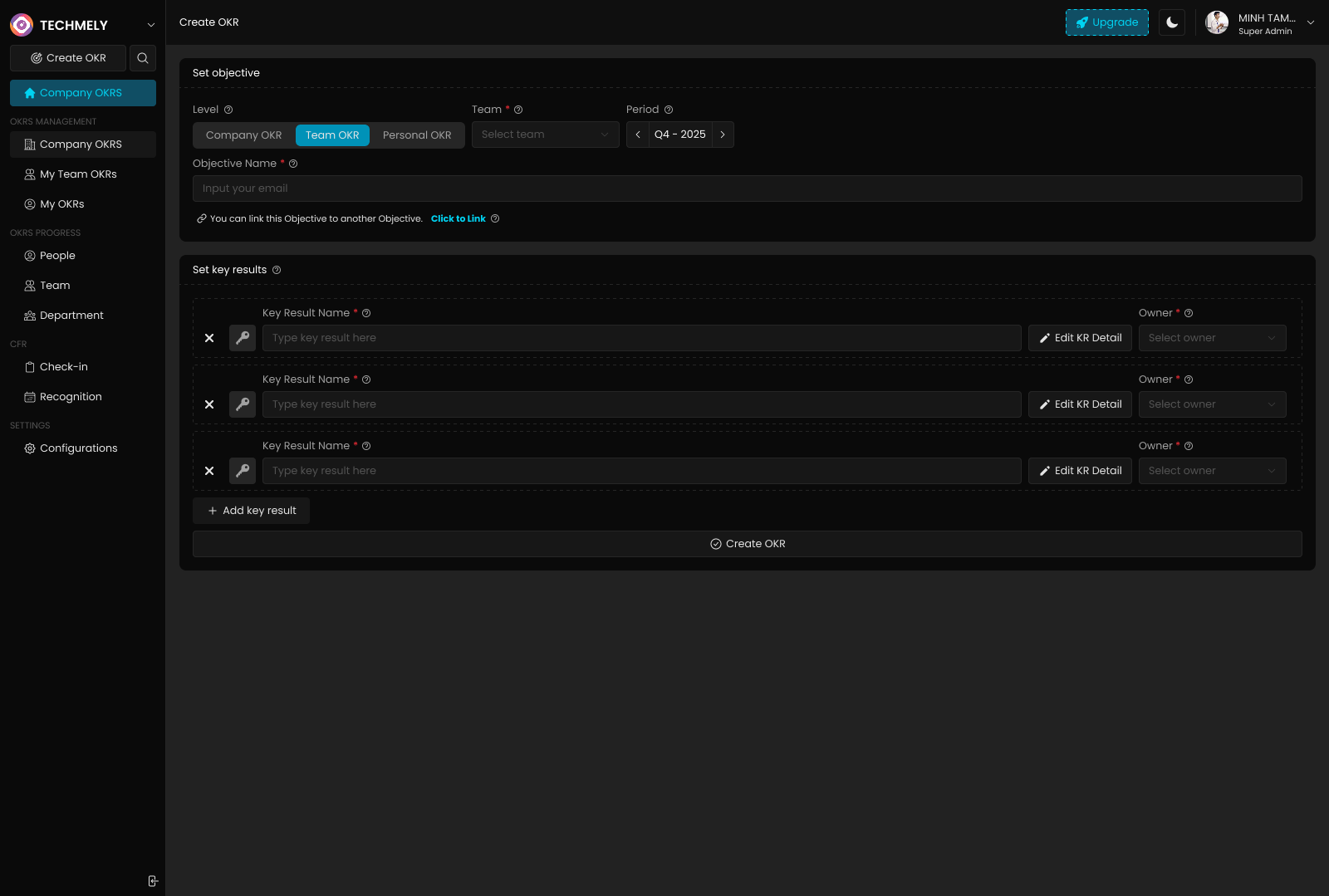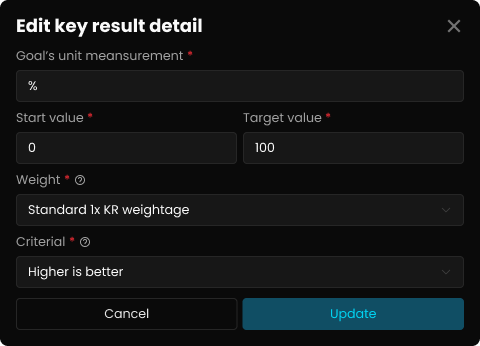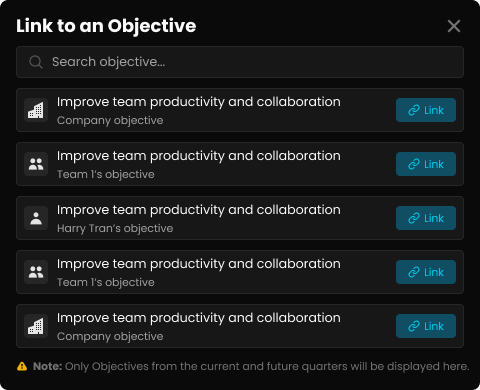Create Team-Level OKR
Step-by-step guide to creating effective team-level Objectives and Key Results in AntOKR
Create Team-Level OKR
Overview
Team-level OKRs bridge the gap between company strategy and individual execution. They translate high-level organizational objectives into specific, actionable goals that teams can own and execute. Team OKRs should align with and support company objectives while addressing the unique challenges and opportunities within each team's domain.
What are Team-Level OKRs?
Team-level OKRs are collaborative objectives that:
- Align with company goals: Support broader organizational objectives
- Focus team efforts: Unite team members around common outcomes
- Enable autonomy: Give teams ownership over how they achieve results
- Foster collaboration: Encourage cross-functional teamwork
- Drive accountability: Create shared responsibility for outcomes
Who Can Create Team OKRs?
Based on AntOKR's permission system:
- Administrators: Can create OKRs for any team
- Team Leaders: Can create OKRs for their own teams
- Team Members: Can create OKRs for teams they belong to
Important: Team members must be invited to the team before you can assign OKRs to them.
Step-by-Step Guide
Step 1: Set Up Your Team OKR
Navigate to the OKR creation interface and configure the basic settings.

- Click "Create OKR" from your dashboard
- In the Level section, select "Team OKR"
- Choose your Team from the dropdown
- Select the appropriate Period (e.g., Q4 - 2025)
- Assign an Owner (team lead or key contributor)
Step 2: Define Your Team Objective
Your team objective should clearly state what the team wants to accomplish and how it contributes to larger organizational goals.
Characteristics of Strong Team Objectives:
- Specific to team's function and expertise
- Aligned with company or department objectives
- Inspiring and motivational for team members
- Achievable within the team's capabilities
- Clear about the value delivered
Example Team Objectives by Function:
Marketing Team:
- "Increase brand awareness and generate qualified leads for sales"
- "Launch successful product marketing campaign for new feature"
Engineering Team:
- "Improve product reliability and user experience"
- "Accelerate development velocity while maintaining quality"
Sales Team:
- "Exceed quarterly revenue targets and expand customer base"
- "Improve sales process efficiency and customer acquisition"
Customer Success Team:
- "Increase customer satisfaction and reduce churn"
- "Scale customer onboarding and support processes"
Step 3: Create Meaningful Key Results
Key Results should be specific, measurable outcomes that indicate progress toward your team objective.

Configuring Key Result Details
Measurement Setup:
- Goal's unit measurement: Select appropriate unit (%, count, $, etc.)
- Start value: Current baseline or starting point
- Target value: Ambitious but achievable target
- Weight: Relative importance (Standard 1x KR weightage by default)
- Criteria: Success direction (Higher is better, Lower is better)
Ownership Assignment:
- Team: Pre-filled based on your selection
- Owner: Specific team member responsible for this key result
Examples of Team Key Results
Marketing Team KRs:
- "Increase website traffic from 10,000 to 25,000 monthly visitors"
- "Generate 500 marketing qualified leads (MQLs) per month"
- "Achieve 4.5/5 average score on campaign effectiveness surveys"
Engineering Team KRs:
- "Reduce average page load time from 3s to 1.5s"
- "Increase automated test coverage from 60% to 85%"
- "Deploy 15 new features without any critical bugs"
Sales Team KRs:
- "Achieve $500K in new revenue for the quarter"
- "Increase lead-to-customer conversion rate from 15% to 25%"
- "Onboard 3 new enterprise clients"
Step 4: Link to Higher-Level Objectives (Optional)
Consider linking your team objectives to company or departmental objectives to show alignment.

Benefits of Linking Objectives:
- Creates clear line of sight to company goals
- Shows how team work impacts organizational outcomes
- Enables better strategic alignment tracking
- Facilitates cascade communication
Rules for Linking:
- Can only link to current or future objectives
- Cannot link longer periods to shorter periods
- Company objectives cannot be linked to team objectives
Step 5: Review and Finalize
Before creating your team OKR, ensure:
- Team Readiness: All necessary team members are invited
- Alignment Check: Objectives support higher-level goals
- Ownership Clarity: Each key result has a responsible owner
- Measurability: All metrics are clearly defined and trackable
- Achievability: Targets are ambitious but realistic for the team
Best Practices for Team OKRs
1. Collaborative Planning
Team Involvement:
- Include the entire team in OKR planning sessions
- Gather input on what's achievable and meaningful
- Ensure buy-in from all team members
- Discuss dependencies and potential blockers
Cross-Team Coordination:
- Identify dependencies with other teams
- Coordinate on shared objectives or key results
- Communicate interdependencies clearly
2. Balanced Focus Areas
Mix of Objectives:
- Core business metrics (performance, efficiency)
- Innovation and improvement initiatives
- Team development and capability building
- Customer/stakeholder satisfaction
Avoid Common Pitfalls:
- Too many objectives (limit to 3-4 per quarter)
- Objectives that are just regular work
- Key results that aren't truly measurable
3. Regular Team Alignment
Weekly Team Check-ins:
- Review progress on key results
- Identify blockers and support needed
- Celebrate wins and learn from challenges
- Adjust tactics while keeping objectives stable
Monthly Reviews:
- Assess overall OKR health
- Update progress and projections
- Realign priorities if needed
- Plan for upcoming initiatives
Team OKR Templates
Product Development Team
Objective: "Deliver high-quality features that delight users"
Key Results:
- Increase user satisfaction score from 4.2 to 4.7
- Reduce feature development cycle time by 25%
- Achieve 98% uptime for all core product features
Customer Support Team
Objective: "Provide exceptional customer support experience"
Key Results:
- Maintain average response time under 2 hours
- Achieve 95% customer satisfaction rating
- Reduce ticket escalation rate to less than 5%
Data Analytics Team
Objective: "Enable data-driven decision making across organization"
Key Results:
- Deliver 10 new analytics dashboards for business teams
- Reduce data processing time by 40%
- Train 50 employees on data analysis tools
Tracking and Managing Team OKRs
Progress Updates
Regular Updates:
- Weekly progress tracking by key result owners
- Bi-weekly team alignment meetings
- Monthly reviews with stakeholders
Transparency:
- Share progress with entire team
- Communicate blockers and challenges
- Celebrate achievements and milestones
Handling Challenges
Common Issues and Solutions:
Resource Constraints:
- Reprioritize key results based on impact
- Seek support from leadership
- Consider scope adjustments
Dependency Delays:
- Proactive communication with dependent teams
- Create contingency plans
- Escalate blockers to management
Changing Priorities:
- Assess impact on OKR relevance
- Consult with leadership on adjustments
- Document rationale for any changes
Integration with Other OKR Levels
Alignment with Company OKRs
- Ensure team objectives support company goals
- Use objective linking to show connections
- Regular alignment reviews with leadership
Supporting Personal OKRs
- Help team members create personal OKRs that align
- Ensure individual goals complement team objectives
- Provide coaching and support for personal development
Next Steps
After creating your team OKR:
- Communicate: Share with all team members and stakeholders
- Plan: Break down key results into actionable tasks and milestones
- Execute: Begin working toward your objectives with regular check-ins
- Monitor: Track progress and adjust tactics as needed
- Learn: Capture insights for future OKR planning cycles
Troubleshooting
Team Member Assignment Issues
Problem: Cannot assign OKRs to team members Solution: Ensure all team members are properly invited to the team before creating OKRs
Alignment Challenges
Problem: Team OKRs don't clearly support company objectives Solution: Schedule alignment sessions with leadership to clarify connections and priorities
Measurement Difficulties
Problem: Hard to quantify some team outcomes Solution: Use proxy metrics, qualitative assessments, or milestone-based measurements
Team OKRs are essential for translating strategy into execution. When implemented effectively, they create focus, alignment, and accountability while empowering teams to own their outcomes and drive meaningful results.
Suggested Related Articles
User Management
Complete guide to managing users, roles, permissions, and team assignments in AntOKR
Change OKR Owner
Complete guide to changing ownership of OKRs across different levels with proper permissions and best practices
OKR Progress Tracking
Complete guide to tracking and monitoring OKR progress across departments, teams, and individuals with detailed analytics and insights
Manage OKR Actions
Complete guide to managing OKR actions including editing, updating, linking, and deleting objectives and key results
Company Configuration
Complete guide to configuring and managing your company settings, branding, and organizational preferences in AntOKR
Login
How to access your AntOKR account